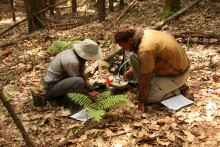You are here
Forest Soil Respiration: A 22-Year Analysis

Through respiration and photosynthesis, terrestrial soils and plants control 1/6 of all carbon present in the atmosphere. Results from more than 100,000 individual measurements of forest soil respiration, conducted at the Harvard Forest by scientists from 8 institutions over 22 years, casts new light on how carbon cycles through these complex plant and soil systems. The research team analyzed the soil respiration data alongside Harvard Forest's 24 years of atmospheric carbon flux records, further clarifying where and how the carbon is released and stored over time.
Among other findings, the data reveal major seasonal shifts in carbon dioxide release, with more CO2 released aboveground from trees and other plants in early spring, followed by a greater release of CO2 from belowground by soil microbes and plant roots later in the season, after the forest canopy develops.
The individual studies contributing to this work, one of the largest efforts of its kind in the world, involved hundreds of scientists and students, and was funded by the National Science Foundation, the Long-Term Ecological Research Program, and the U.S. Department of Energy.

